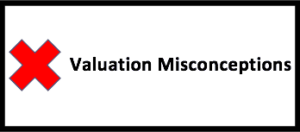
The first common misconception stems partly from the term “valuation.” Many people assume “valuation” means formula, and there’s a set method in which numbers are plugged in to determine the value of a business. While various formulas eventually could be part of a valuation, the real effort and hours of analysis undertaken by a business valuer are at the heart of the valuation. It is the valuer’s knowledge, qualifications and experience that derive the figures to apply the formula to in the first place that is so important and often overlooking by business owners.
The second common misconception is that “ Businesses in my industry always sell for two times annual revenue (the revenue multiple). So why should I pay someone to value my business?” The short answer is that data on selling prices indicate that revenue multiples within an industry are generally unreliable. These rules of thumb, often used by business brokers, the individuals who often facilitate private business sales, frequently ignore the fact that businesses actually need working capital. When they indicate a business has a R.O.I (return on investment) of 40%, a buyer may well assume that if they pay $800,000, they will earn $320,000. However, they may well find that the business needs $150,000 of working capital. Is this capital free? Of course not. This capital has to be factored into the R.O.I. The experienced business brokers will usually do this. Not all though. Rules of thumb are notoriously unreliable. Every single business is different from the next, and every single business has to be valued on its own merits. Valuing a business is a very fact specific endeavour. Even if you know the values of some of your competitors’ businesses, that is no substitute for the value of your business. There are so many variables in a business valuation that you should not just assume the value of your business based on other businesses. It is always better to value your business based on all of your business’s factors.
The third common misconception is that “I Valued My Business Once, So I Won’t Have to do It Again”
Valuing a business is the same as valuing other things. Values rise and fall, and sometimes dramatically in a short period of time. Just because you valued your business a few years ago does not mean that the current value is the same. In fact, it’s much more likely that the value has changed. Think about how much the value of a stock changes on the Stock Exchange. Businesses change in the same ways.
Also, a business valuation only applies to the particular date in which its valuation is completed.
The fourth common misconception is that “I have had my business valued; is this the price I will get for it?”
The value of a business is determined through careful analysis, by an experienced valuation professional, considering numerous factors regarding the nature and characteristics of the business, as well as the industry and economy in which it operates. The valuer will consider a number of valuation approaches in order to arrive at a valuation conclusion that will provide a notional investor with a reasonable return on investment, given the risks of the business. This is often referred to as a ‘notional’ valuation.
The price of a business may be higher or lower than the value indicated by a notional valuation. Some of the factors influencing price include different purchaser vs vendor negotiating strengths, different risk assessments, structure of the transaction, synergies, and non-economic considerations. These factors and the price of a business can only be determined with any degree of certainty when a business is exposed for sale in the open market.
